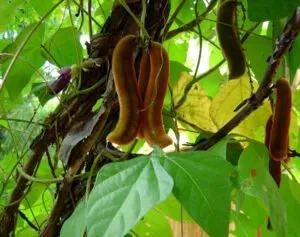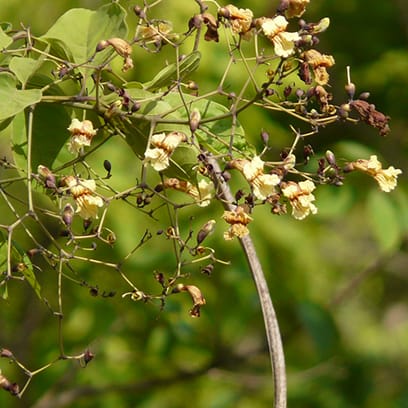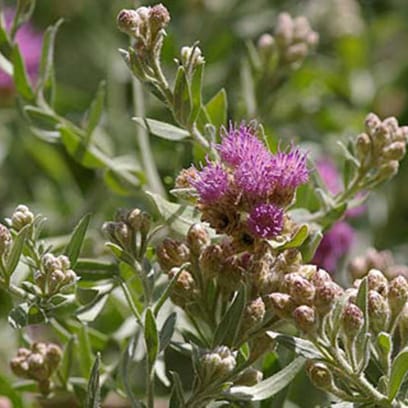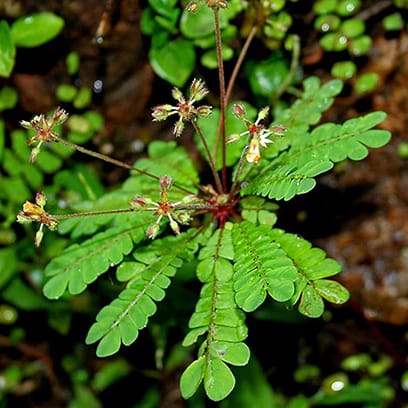On This Page
Kapikacchu – Mucuna pruriens
Kapikacchu, commonly known as ‘Cowhage’ is an annual hairy pea-like climber (twining herb) on shrubs and trees, found throughout tropical regions in India. The name ‘Kapikacchu’ indicates that the hairs on it’s fruit causes itching to monkeys. The word ‘Mucuna’ is a name in Brazilian language and ‘pruriens’ means that which produce itching. Kapikacchu possess aphrodisiac properties and can pacify all three doshas ie; Vata, Pitta and Kapha.
It has been also found out that the seed extract of Cowhage shows effective antidiabetic activity. Ethanolic extract of leaves of Kapikacchu have antiepileptic and anticataleptic actions. The ethanolic extract of seeds of this plant is found to be effective in enhancing sexual behavior and sperm parameters in males. In infertile men Cowhage seeds reactivates the antioxidant defense system, reduces stress and improves semen quality.
Action of Kapikacchu – Mucuna pruriens in Allergies
IAFA experts are putting continuous efforts to prove the antiallergic property of Cowhage. The plant contains phytoconstituents like mucuadine, mucuadinine, mucuadininine, prurienidine, L-dopa, glutarthione, lecithin, gallic acid, amino acids like histidine, lysine, tyrosine and valine.These phytoconstituents contribute to its actions like antiallergic and anthelmintic. It also pacifies Vata, Pitta and Kapha doshas. It is a widely used medicinal plant and it’s seed powder can be used in allergic reactions.
Vernacular Names
| Botanical Name | Mucuna pruriens |
| Family | Papilionaceae |
| Native Names | |
| Sanskrit Name | Kapikacchu, Guptapala, Svagupta, Atmagupta, Markati, Kandura, Shukashimbi |
| Hindi Name | Kiwach |
| English Name | Cowhage |
| Malayalam Name | Nayikuruna |
| Kannada Name | Nasugunni |
| Marathi name | Kuhili |
Botanical Name
Mucuna pruriens
Family
Papilionaceae
Morphology of Kapikacchu – Mucuna pruriens
- Annual hairy pea-like climber (twining herb) on shrubs and trees.
- Branches tomentose when young.
- Leaflets are long and leaflets grows up to 19 x 16 cm.
- Pods sigmoid, 5-8 cm long, 5-6 seeded; irritating bristles caduceus.
- Seeds are matured, blackish white or black.
Ayurveda reference of Kapikacchu – Mucuna pruriens

Geographical distribution of Kapikacchu – Mucuna pruriens
Plant is occurring throughout tropical regions in India. It is found throughout country from Himalaya to Ceylon and Burma plain regions in wild state. Plant is also cultivated.
Phytoconstituents of Kapikacchu – Mucuna pruriens
The plant contains phytoconstituents like mucuadine, mucuadinine, mucuadininine, prurienidine, L-dopa, glutarthione, lecithin, gallic acid, amino acids like histidine, lysine, tyrosine and valine.
Parts used of Kapikacchu – Mucuna pruriens
- Seeds
Dosage of Kapikacchu – Mucuna pruriens
- Powder(churna)- 3-6 g
Medicinal Properties of Kapikacchu – Mucuna pruriens
- Pramehahara – cures diabetes
- Balya – promote body strength
- Bramhana – nourishing body
- Vrnanasaka – useful in wounds
- Vajikarana – aphrodisiac
- Sukrakara – promote semen production
- Vrisya – promote sexual potency

Have A Health Issue?
Consult Online
- Dr. Sahil Gupta (B.A.M.S., M.H.A.)
Ayurvedic Allergy Specialist
CEO & Founder of IAFA®
Home remedies of Kapikacchu – Mucuna pruriens
Ayurveda is an ancient system of medicine widely used all over India. Kapikacchu is a commonly seen drug in India, and can be used as different home remedies. Some of them are,
- In Paralysis of brachial plexus (Apabahuka) – The juice of Kapikacchu seeds are taken in brachial plexus paralysis.
- As an Aphrodisiac (Vajikarana) – Powder of Kapikacchu is mixed with powder of Wheat and processed with milk. It is then taken with milk.
- Intheconditionof decreased semen (Sukrakshayam) – Kapikacchu and Asteracanthalongifolia are mixed with sugar and taken with warm milk.
- In Emaciation (Karsya) – The powder of Kapikacchu is processed with milk and taken.
- In loss of Strength (Dourbalya) – Kapikacchu seed powder is processed with ghee and taken.
- In Non healing ulcers (Dustavrna) – Kapikacchu seed powder is mixed with honey and applied over ulcer area.
- In Impotency (Klaibya) – Seed powder of Kapikacchu is mixed with honey and taken to cure impotency.
Dr.Gupta’s IAFA has been conducting research programmes to identity the phytoconstituents and actions of various drugs used in Ayurveda. Our system mainly aims in the growth of Ayurveda science and maintains a strict protocol to ensure the safety of all consumers. The well experienced members of IAFA are consistently working to find out the most effective ways to cure all diseases especially Allergic disorders. All the herbs used in our system are mentioned in the basic texts of Ayurveda and are collected naturally.
Reach IAFA for safe herbal remedies for all your ailments!!!
Was this Page Helpful?
Read More Articles

Patala (Stereospermum Suaveolens)
Know about therapeutic uses, benefits and medicinal properties of Patala (Stereospermum Suaveolens).…

Rasna (Pluchea lanceolata)
Know about therapeutic uses, benefits and medicinal properties of Rasna (Pluchea lanceolata).…

Mukkutti (Biophytum Sensitivum)
Know about therapeutic uses, benefits and medicinal properties of Mukkutti (Biophytum Sensitivum).…









